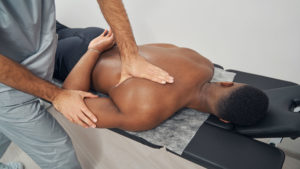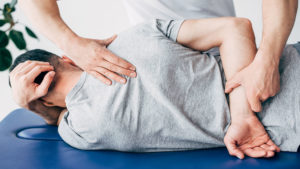Most people have experienced back pain at some point in their lives. It’s actually the leading cause of disability worldwide and the most common reason people call out of work. Back pain can come in many different forms, ranging from a dull ache that lasts only a few days to severe pain that lasts for weeks. Get the answers and the help you need here to find comfort in life again.
What is the safest way to relieve back pain?
Thankfully, several safe options are available to reduce or eliminate back pain. Many therapies can help with back pain, such as physiotherapy, massage, chiropractic care, and acupuncture. People have also found relief from meditation, diet, and other alternative treatments. The safest option depends on what causes your pain and your doctor’s recommendations.
What can cause lower back pain?
Most low back pain results from an injury, such as muscle sprains or strains due to sudden movements or poor body mechanics while lifting heavy objects. Other causes can be cancer, herniated disc, sciatica, arthritis, and kidney infections. In addition, people often experience lower back pain because of poor posture or sitting all day.
For other people, that pain may be associated with a curvature of the spine, fibromyalgia, inflammation, a degenerative disorder, uterine problems, or pregnancy. If you do not know the cause, schedule an appointment with your doctor to help determine the cause. Once you know what is causing the pain, you and your doctor can find a treatment plan.
How do I know if lower back pain is serious?
In many cases, lower back pain stops on its own. But if it does not, then you need to know when to see a doctor. If your pain lasts longer than a month, gets worse with time, or you experience other new symptoms with the back pain, then get in to see a doctor sooner than later. Additional symptoms to look for include pain radiating to other body parts, numbness, tingling, weakness, sharp pain, or pain after an accident or fall.
Furthermore, if your pain worsens at certain times or when you are in certain positions, you may need more help than over-the-counter meds. Problems with your bowels or urination are other symptoms you should not ignore. A fever can indicate an infection or other complications. Finally, if you experience sudden weight loss that cannot be explained by diet and lifestyle changes, you should always pay attention to what your body tells you, especially with weight loss.
How long should lower back pain last?
Most back pain will subside after a few days, but if you’ve been experiencing it for over a week, it’s time to call a doctor. Your doctor will perform any examinations or tests required to help you get to the bottom of your pain before it could become a bigger problem. As is the case with many health conditions, prevention and addressing problems early is key.
How long does it take for lower back pain to go away?
If your back pain is acute, it probably means your pain came along suddenly. Things like stress, strenuous exercise, an awkward movement, or lifting something wrong can all contribute to acute back pain. However, most back pain is diagnosed as acute unless it lasts longer than six weeks. And in most cases, the underlying cause of the pain does not pose a serious or long-term problem.
Chronic back pain, on the other hand, can be serious. Chronic pain is serious because the symptoms are strong enough to impact your health, mobility, and quality of life for an extended period of time. While chronic back pain can come on suddenly, it usually builds gradually and lasts more than six weeks. Often chronic back pain can be recurrent, meaning it will go away at times but regularly come back.
Is a massage good for lower back pain?
Multiple published research demonstrates the benefits of massage for back pain. Collected over the years, we now know massage can reduce or eliminate pain, relax tight muscles, improve blood circulation, and reduce stress and anxiety. In addition, massage can be added to conventional treatments such as pain relievers and heat packs. A physiotherapist will include massage as one element of a treatment plan that may include activities like light exercises and stretching for lower back pain.
Can stretching make back pain worse?
Low back pain often stems from flexion intolerance, or basically, the pain comes from bending forward. This could be from bending over to pick something up off the ground with a rounded back or just sitting at a desk for 8 hours a day for years. This can push the vertebral discs backward, which leads to herniated discs and nerve pinching. Basically, when you stretch out your back, you are actually creating low back pain.
Even a good feeling from a stretch could mean you are over-stretching, and a few minutes later, you may notice discomfort. When your lower back is flexed, rounded, or slumped, you are already stretching out some muscles and ligaments in addition to pushing your disc out the back. This is a dangerous position to be in, which is why you should avoid stretching without a physiotherapist if you have lower back pain.
While stretching is highly recommended before physical activity and even as a way to release tight muscles in the morning, it may not be wise when suffering with current back pain. It can aggravate the muscles that are already inflamed due to injury. It is always better to seek the advice of a doctor or physiotherapist when trying to release tight muscles and do away with soreness.
What is the best position to sleep if you have lower back pain?
The best position to avoid back pain is lying flat on your back, although not everyone can comfortably sleep on their back. Side sleeping with your legs straight is the second-best position for avoiding back and neck pain. No matter what position you choose, keeping proper alignment of your spine is the most important part of the equation. Focus specifically on aligning your ears, shoulders, and hips and choosing a pillow that helps you to achieve the proper sleep position.
Is walking good for lower back pain?
When you walk, the muscles that support your spine get stronger. Your trunk, core, and lumbar (lower back) muscles are very important to keep your lower back stable and able to move. A sedentary lifestyle can make these muscles weak and out of shape, which can cause the spine to be out of place. Over time, muscle pain, injury, and weakness may get worse.
Walking can increase blood flow throughout your body. Furthermore, it can reduce or rid your body of toxins. Over time, these toxins can build up in the muscles of the lower back and make them stiff. Walking helps get rid of these wastes and makes you more flexible. All of these things help build strength in the muscles of your lower back.
Finally, when you walk, you stretch the muscles and ligaments in your back, legs, and buttocks. This makes you more flexible. When you walk, you use and stretch certain muscles, like your hamstrings, erector muscles of the spine, and hip flexor muscles. As a result, your spinal ligaments and tendons also become more flexible, which improves the range of motion in your lower back as a whole.
How do you know if back pain is muscular or spinal?
A single traumatic experience does not usually cause pain in a muscle or ligament. Usually, it’s caused by a sudden, awkward movement like a big fall. Most of the time, non-specific muscle strains are caused by overuse or repeated physical stress, like lifting, twisting, or stretching the lower back. An athlete’s muscles and ligaments that are used too much can cause back pain. In the same way, you might feel sore and stiff after a few hours of yard work or after lifting something heavy the wrong way.
Spinal pain often does not go away after a couple of weeks. Non-surgical discomfort in the low back, neck, and thorax usually only affects the central or para-spinal soft tissue, not the arms, chest, or legs. Additional signs include stiffness or limited range of motion, inability to maintain proper posture, muscle spasms, and a notable decline in motor abilities, such as the capacity to heel or tiptoe walk.
Portland Wellness Care employs a wide variety of therapies to help people with lower back pain. We offer chiropractic services, physotherapy, massage, and other medical specialists on staff who can help with a wide range of problems. When you come to our clinic, you will get a treatment plan that is made just for you based on your needs and situation.
We offer same-day appointments and walk-ins to help you feel better. Moreover, we can also help you live a better life by getting your body to work well through massage, sports medicine, and other things. Call Portland Wellness Care today to set up an appointment with one of our medical specialists. This will be the first step on your road to recovery.
Conclusion
Lower back pain can overcomplicate your life, but multiple therapies offer relief and respite. Portland Wellness Care offers the help you need to get back to living and leave pain in the past. No matter what causes your lower back pain, we will work with you to find the right treatment including alternative options that are more affordable and less dependent on medications or surgery. Call today and schedule an appointment.












